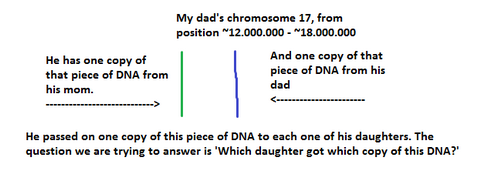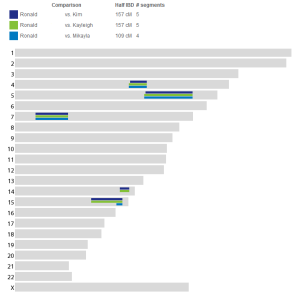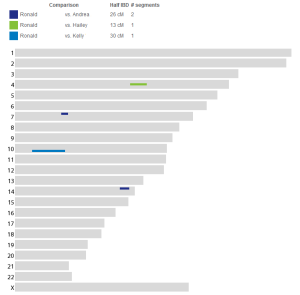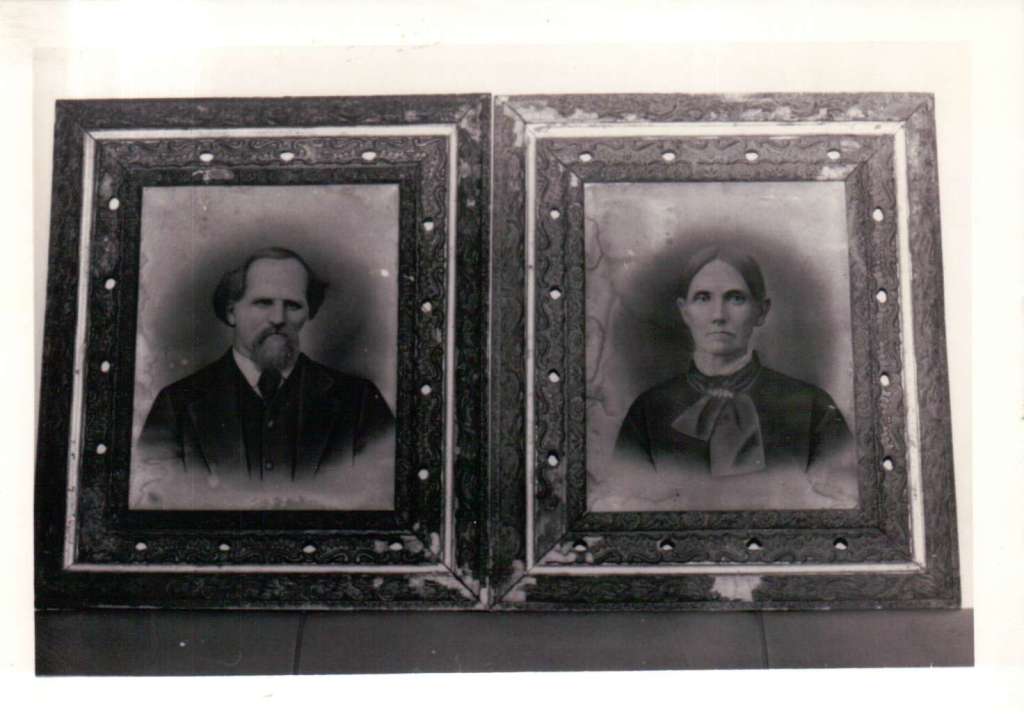I am going to examine the Ancestry Composition chromosome paintings and ring charts from a wide variety of 23andMe members so that we can see how Ancestry Composition differs from the old Ancestry Painting, and how the results compare to what people know about their own ancestral background.
PERSON #1
Known Ancestral Background: 4 German great-grandparents, one Welsh great-greandparent, one Native American great-grandparent (probable European admixture), one English great-grandparent, one Scottish/Ashkenazi Jewish great-grandparent
Known Ancestral Background: 4 German great-grandparents, one Welsh great-greandparent, one Native American great-grandparent (probable European admixture), one English great-grandparent, one Scottish/Ashkenazi Jewish great-grandparent
Here is Person 1's original Ancestry Painting.
Person #1 has European ancestry from a variety of countries -- in Ancestry Painting 1 (hereafter referred to as AP1), all of this European ancestry is represented by the plain dark blue. Person 1 also inherited a number of non-European segments from his Native American great-grandparent, which are highlighted in orange. Overall, in AP1 this person gets a 96% European and 4% Asian score.
Here is person #1's new Ancestry Composition.
You can see that his European ancestry is now broken down into subgroups.
- He has one Welsh great-grandparent and one British great-grandparent. Each one of these ancestors contributed an estimated 12.5% of person #1's DNA. He also has a great-grandparent who is part Scottish. Overall, he is approximately 30% British. His "British and Irish" score hits the mark almost perfectly -- 24.2%.
- Person #1 is approximately 50% German. Ancestry Composition picks up on this DNA in several ways. His "French and German" score is 13.7%. Also, his "Eastern European" score is 4.3%. Historically, borders have changed & the German and Polish ethnic groups have interbred quite a bit. This means that Person #1's German ancestors likely had deeper ancestry that could be traced back to Eastern Europe, and this is what is showing up in Person #1's Ancestry Composition.
So, we're up to 13.7% French and German + 4.3% Eastern Europe = 18 of Person #1's total of 50 percent German ancestry is accounted for.
Where is the rest?
Not all of Person #1's German DNA is able to be tagged as uniquely and solely German. For more information about this, please visit this FAQ as well as this excellent guide that 23andMe has published. What we can conclude from this is that much of Person #1's German DNA is unable to be tagged as DNA that is found only in German -- therefore it is under the category of "Nonspecific Northern Europe" and "Nonspecific Europe."
- Person #1 also has a small amount of Ashkenazi admixture. In AP1, this admixture remained undifferentiated from Person #1's European DNA. But Ancestry Composition has tagged it all perfectly. Person #1 gets a score of 2.4% Ashkenazi.
- Ancestry Painting 1 was able to successfully differentiate Person #1's European DNA from his Asian DNA. But Ancestry Composition goes one step further -- it is able to accurately determine that Person #1's Asian DNA is Native American in origin. Before, with AP1, a variety of Asian DNA such as Chinese, Japanese, and Native American were all placed in the same category and unable to be differentiated from one another. But with Ancestry Composition, Person #1's Native American DNA that he inherited from his Native American great-grandparent is correctly tagged as such.
PERSON #2
Known Ancestral Background: 100% Mexican
Known Ancestral Background: 100% Mexican

Once again, we see that Ancestry Composition has done an excellent job at further subdividing this person's DNA into different world subgroups. Previously, Person #2's DNA was categorized into just the three simple categories: Europe, Asia, and Africa. Just by looking at Person #2's AP1, you wouldn't really be able to guess which region of the world she originated from.
Ancestry Composition makes this much clearer. The generic Asian DNA from AP1 is now highlighted as being predominantly Native American in origin. We also see that a significant portion of Person #2's European DNA can be properly categorized as Southern European DNA, much of which can be further tagged as originating from Spain/the Iberian peninsula.
Before, with AP1, we saw generic European DNA plus generic Asian DNA plus a smidge of African DNA. That doesn't say much about this person's origin. But with Ancestry Composition, this person's mestizo heritage -- Native American plus Iberian -- comes through quite clearly.
PERSON #3
Known Ancestral Background: half Bulgarian and half Turkish
It's a very similar story with person #3. His AP1 is quite similar to person 1's, so it's reasonable to suppose that, like person #1, he also has primarily European ancestry with a distant Native American ancestor. Just by using AP1, there's no way of proving or disproving this hypothesis.Known Ancestral Background: half Bulgarian and half Turkish
Ancestry Composition comes through and delivers a strikingly different picture, though.
- This person has a mix of Bulgarian and Turkish ancestry, and accordingly, Ancestry Composition clearly tags much of this person's European DNA as being Southern/Eastern European, with the lion's share tagged as originating in the Balkan peninsula.
- Person #3's Arab portion is correctly differentiated as Middle Eastern, and reflect's person #3's Turkish ancestry
PERSON #4
Known Ancestral Background: 7/8 Irish, 1/8 Scottish
Known Ancestral Background: 7/8 Irish, 1/8 Scottish
- Person #4's original Ancestry Painting lists her as being 100% European. This is perfectly consistent with what Person #4 knows about her ancestry, but is quite generic
- Ancestry Composition zooms in a bit deeper and is able to readily identify all of the British Isles heritage that person #4 has. Her ancestral background is 100% British and Irish, and her Ancestry Composition score is 86.1% "British and Irish." The leftover portion is largely tucked into the "nonspecific Northern Europe" category, meaning that some of her British/Irish DNA is not specific to the British Isles, but is instead found throughout Northern Europe.
- There are a couple of tiny segments showing a very small amount of North African ancestry. This could be statistical noise or it could be indicative of a trace amount of DNA from a historical migration pattern.
PERSON #5
Known Ancestral Background: African-American

One thing I want to highlight in this person's painting that I haven't previously discussed is the power of phasing. Phasing means separating your maternal complement of chromosomes from your paternal complement of chromosomes. Ancestry Painting #1 was entirely unphased, but Ancestry Composition contains a step in which the genome is phased (for more info, read here).
Separating the paternal side of your genome out from your maternal side gives you a clearer picture of what you are looking at in terms of your ancestry.
Here's an example, with AP1 on top and AP2 on the bottom. In AP1, it's a zigzag mess with tiny Asian, African and European chunks interspersed with one another. This is because the data is unphased. Phasing smooths it out dramatically and we can now see, for example, that this person inherited a large piece of African DNA from one parent on chromosome 5 and Native American DNA from the other parent. It's separated out rather than hodgepodged together like it was with AP1. This can potentially be a great help when used in combination with Family-Inheritance and Relative Finder -- phased chromosome painting may show more clearly what region a shared segment likely comes from.
That's all for now!
Check back soon for my upcoming posts, which will focus on the Ancestry Composition of these individuals:
- Person #6: Known Ancestral Background: three quarters German and one quarter Norwegian
- Person #7: Known Ancestral Background: Iranian
- Person #8: Known Ancestral Background: one quarter Swedish, one quarter German (with possible Polish admixture), one half Polynesian
- Person #9: Known Ancestral Background: half Italian, 3/8 Portuguese, 1/8 Danish
- Person #10: Known Ancestral Background: Somali and Ethiopian
- Person #11: Known Ancestral Background: Brazilian
- Person #12: Known Ancestral Background: half African-American, one quarter Icelandic, one quarter Hungarian Jewish
- Person #13: Known Ancestral Background: English, Scottish, German, Ashkenazi Jewish
- Person #14: Known Ancestral Background: half Burmese, half Indian (Tamil)
- Person #15: Known Ancestral Background: Italian, with some Italian Jewish ancestors as well
- Person #16: Known Ancestral Background: one parent African-American, one parent Caucasian
- Person #17: Known Ancestral Background: Colonial American (with most ancestry coming from the Southern states South Carolina, North Carolina, Tennessee, Virginia, and Georgia)
- Person #18: Known Ancestral Background: Mennonite ancestry
- Person #19: Known Ancestral Background: half Dutch, roughly 3/8 Portuguese, and 1/8 African
- Person #20: Known Ancestral Background: n/a, adoptee
- Person #21: Known Ancestral Background: half African-American, half Ethiopian
- Person #22: Known Ancestral Background: Lebanese/Turkish/Assyrian
- Person #23: Known Ancestral Background: half Indian, half Italian
- Person #24: Known Ancestral Background: 7/8 colonial American, 1/8 Polynesian
- Person #25: Known Ancestral Background: colonial American
- Person #26: Known Ancestral Background: colonial American
- Person #27: Known Ancestral Background: at least one quarter Chinese, at least one quarter Jamaican, some English, Irish, German, and African ancestors
- Person #28: Known Ancestral Background: n/a, adoptee
- Person #29: Known Ancestral Background: Saudi Arabia and Kuwait
- Person #30: Known Ancestral Background: 100% Chinese
-
Person #31: Known Ancestral Background:
three Caucasian (primarily Swedish and Irish) great-grandparents, five
African-American great-grandparents
Person #32: Known Ancestral Background: half colonial American, half mixed European (mom is 1/8 English, 3/8 Irish, 3/16 Scottish, 1/4 German, 1/16 Ashkenazi) - Person #33: Known Ancestral Background: half Russian, half German
- Person #34: Known Ancestral Background: Predominantly French with some Spanish and Italian admixture
- Person #35: Known Ancestral Background: Spanish, Jewish, Mexican, French, Italian, and Portuguese
- Person #36: Known Ancestral Background: Predominantly of Mexican ancestry, with Native American, German, and colonial American ancestors as well
- Person #37: Known Ancestral Background: half Romanian Jewish, half Hungarian
- Person #38: Known Ancestral Background: 100% Italian
- Person #39: Known Ancestral Background: 100% Finnish
- Person #40: Known Ancestral Background: half Irish, half colonial American
- Person #41: Known Ancestral Background: Polynesian and Caucasian (English and German)
- Person #42: Known Ancestral Background: 3/8 Irish, 1/8 Scottish, about 1/4 colonial American, about 1/4 French Canadian
- Person #43: Known Ancestral Background: half Russian, other parent unknown
- Person #44: Known Ancestral Background: African American (with ancestors from South Carolina, North Carolina, and Puerto Rico)
- Person #45: Known Ancestral Background: Italian and Polish Jewish ancestors
- Person #46: Known Ancestral Background: half Dutch, also African, Italian, Spanish, and distant Native American ancestors
- Person #47: Known Ancestral Background: half Norwegian, half colonial American
- Person #48: Known Ancestral Background: n/a, adoptee
- Person #49: Known Ancestral Background: 100% German
- Person #50: Known Ancestral Background: Ashkenazi Jewish
- Person #51: Known Ancestral Background: half Colombian, half Italian
- Person #52: Known Ancestral Background: French and Belgian
- Person #53: Known Ancestral Background: 100% Turkish
- Person #54: Known Ancestral Background: 100% Greek
- Person #55: Known Ancestral Background: at least half Mennonite, other parent is colonial/Mennonite mix
- Person #56: Known Ancestral Background: one quarter Indian, one quarter Burmese, one half colonial American
- Person #57: Known Ancestral Background: n/a, adoptee
- Person #58: Known Ancestral Background: colonial American
- Person #59: Known Ancestral Background: colonial American
- Person #60: Known Ancestral Background: n/a, adoptee


































